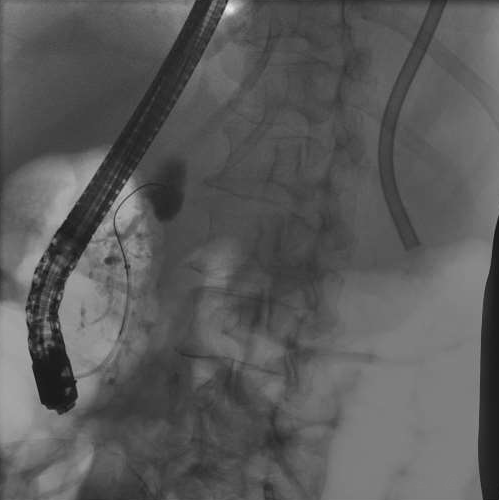Sunday Poster Session
Category: Biliary/Pancreas
P0115 - Missed Connections: How Delayed ERCP Prolonged Suffering in Pancreaticopleural Fistula
Sunday, October 26, 2025
3:30 PM - 7:00 PM PDT
Location: Exhibit Hall

Essam Rashad, MBBCh
Parkview Medical Center
Fort Wayne, IN
Presenting Author(s)
Essam Rashad, MBBCh1, Abdul Haseeb, MD, MPH2
1Parkview Medical Center, Fort Wayne, IN; 2Midwest Digestive Health & Nutrition, Hinsdale, IL
Introduction: Pancreaticopleural fistula (PPF) represents a rare but serious complication of pancreatitis. The most common symptom is dyspnea, followed by cough and chest pain. Due to these predominantly pulmonary symptoms, rather than abdominal complaints, the diagnosis is frequently delayed. Thus, the condition requires a high index of suspicion particularly in the setting of alcohol-induced pancreatitis. We present a case of PPF in a patient with established chronic pancreatitis that was diagnosed and managed with drainage via endoscopic retrograde cholangiopancreatography (ERCP).
Case Description/
Methods: A 54-year-old woman with chronic alcohol-related pancreatitis, multifocal pancreatic pseudocysts, and heavy tobacco use presented with 7 months of recurrent left-sided chest pain and dyspnea. She underwent four thoracenteses for pleural effusions with elevated amylase levels (524-36,830 U/L). MRI showed pancreatic atrophy with a body pseudocyst. ERCP demonstrated a dilated main pancreatic duct communicating with the pseudocyst, confirming pancreatic-pleural fistula. Sphincterotomy and pancreatic stent placement were performed. Due to recurrent symptoms one month later, the patient underwent left thoracotomy with decortication and pleurodesis.
Discussion: Pancreaticopleural fistulas (PPF) are rare complications of pancreatitis, most often presenting with pulmonary symptoms such as dyspnea, cough, and chest pain. Diagnostic delays is common, with the average time to diagnosis reported as approximately 5 weeks. This case exemplifies these challenges, with 7 months of symptoms and four thoracenteses before diagnosis, despite consistently elevated pleural fluid amylase providing key diagnostic clues. The medical literature strongly supports multidisciplinary care involving gastroenterology, pulmonology, radiology, and surgery for optimal management and minimized diagnostic delay. Early ERCP is recommended for both diagnosis and therapy, allowing direct fistula visualization and therapeutic interventions like pancreatic duct stenting. Early ERCP is associated with improved outcomes and reduced morbidity compared to delayed management. The months-long delay in obtaining ERCP in this case contributed to prolonged symptoms and ultimately necessitated surgical intervention. Prompt multidisciplinary evaluation with early ERCP and a high index of suspicion could have shortened the diagnostic timeline and reduced patient morbidity.

Figure: ERCP showing a pseudocyst in the pancreatic duct in the body of the pancreas.
Disclosures:
Essam Rashad indicated no relevant financial relationships.
Abdul Haseeb indicated no relevant financial relationships.
Essam Rashad, MBBCh1, Abdul Haseeb, MD, MPH2. P0115 - Missed Connections: How Delayed ERCP Prolonged Suffering in Pancreaticopleural Fistula, ACG 2025 Annual Scientific Meeting Abstracts. Phoenix, AZ: American College of Gastroenterology.
1Parkview Medical Center, Fort Wayne, IN; 2Midwest Digestive Health & Nutrition, Hinsdale, IL
Introduction: Pancreaticopleural fistula (PPF) represents a rare but serious complication of pancreatitis. The most common symptom is dyspnea, followed by cough and chest pain. Due to these predominantly pulmonary symptoms, rather than abdominal complaints, the diagnosis is frequently delayed. Thus, the condition requires a high index of suspicion particularly in the setting of alcohol-induced pancreatitis. We present a case of PPF in a patient with established chronic pancreatitis that was diagnosed and managed with drainage via endoscopic retrograde cholangiopancreatography (ERCP).
Case Description/
Methods: A 54-year-old woman with chronic alcohol-related pancreatitis, multifocal pancreatic pseudocysts, and heavy tobacco use presented with 7 months of recurrent left-sided chest pain and dyspnea. She underwent four thoracenteses for pleural effusions with elevated amylase levels (524-36,830 U/L). MRI showed pancreatic atrophy with a body pseudocyst. ERCP demonstrated a dilated main pancreatic duct communicating with the pseudocyst, confirming pancreatic-pleural fistula. Sphincterotomy and pancreatic stent placement were performed. Due to recurrent symptoms one month later, the patient underwent left thoracotomy with decortication and pleurodesis.
Discussion: Pancreaticopleural fistulas (PPF) are rare complications of pancreatitis, most often presenting with pulmonary symptoms such as dyspnea, cough, and chest pain. Diagnostic delays is common, with the average time to diagnosis reported as approximately 5 weeks. This case exemplifies these challenges, with 7 months of symptoms and four thoracenteses before diagnosis, despite consistently elevated pleural fluid amylase providing key diagnostic clues. The medical literature strongly supports multidisciplinary care involving gastroenterology, pulmonology, radiology, and surgery for optimal management and minimized diagnostic delay. Early ERCP is recommended for both diagnosis and therapy, allowing direct fistula visualization and therapeutic interventions like pancreatic duct stenting. Early ERCP is associated with improved outcomes and reduced morbidity compared to delayed management. The months-long delay in obtaining ERCP in this case contributed to prolonged symptoms and ultimately necessitated surgical intervention. Prompt multidisciplinary evaluation with early ERCP and a high index of suspicion could have shortened the diagnostic timeline and reduced patient morbidity.

Figure: ERCP showing a pseudocyst in the pancreatic duct in the body of the pancreas.
Disclosures:
Essam Rashad indicated no relevant financial relationships.
Abdul Haseeb indicated no relevant financial relationships.
Essam Rashad, MBBCh1, Abdul Haseeb, MD, MPH2. P0115 - Missed Connections: How Delayed ERCP Prolonged Suffering in Pancreaticopleural Fistula, ACG 2025 Annual Scientific Meeting Abstracts. Phoenix, AZ: American College of Gastroenterology.
